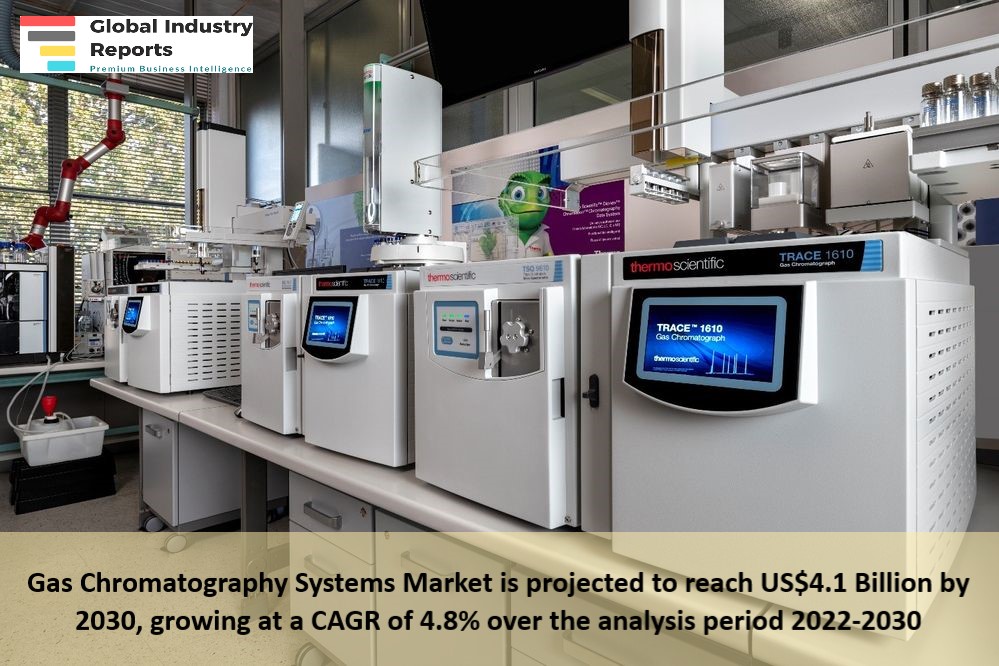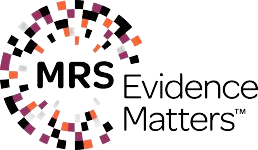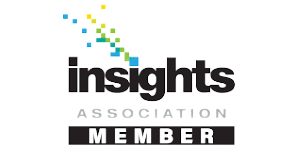Report Overview
- Understand the latest market trends and future growth opportunities for the Gas Chromatography Systems industry globally with research from the Global Industry Reports team of in-country analysts – experts by industry and geographic specialization.
- Key trends are clearly and succinctly summarized alongside the most current research data available. Understand and assess competitive threats and plan corporate strategy with our qualitative analysis, insight, and confident growth projections.
- The report will cover the overall analysis and insights in relation to the size and growth rate of the “Gas Chromatography Systems Market” by various segments at a global and regional level for the 2010-2030 period, with 2010-2021 as historical data, 2022 as a base year, 2023 as an estimated year and 2023-2030 as forecast period.
Description:
- Global market for Gas Chromatography Systems estimated at US$2.8 Billion in the year 2022, is projected to reach a revised size of US$4.1 Billion by 2030, growing at a CAGR of 4.8% over the analysis period 2022-2030.
- Accessories & Consumables, one of the segments analyzed in the report, is projected to record a 4.8% CAGR and reach US$1.8 Billion by the end of the analysis period. Taking into account the ongoing post pandemic recovery, growth in the Reagents segment is readjusted to a revised 5.3% CAGR for the next 8-year period.
- The Gas Chromatography Systems market in the U.S. is estimated at US$1.2 Billion in the year 2022. China, the world`s second largest economy, is forecast to reach a projected market size of US$631.9 Million by the year 2030 trailing a CAGR of 6.6% over the analysis period 2022 to 2030. Among the other noteworthy geographic markets are Japan and Canada, each forecast to grow at 3.2% and 3.8% respectively over the 2022-2030 period. Within Europe, Germany is forecast to grow at approximately 4.4% CAGR. Led by countries such as Australia, India, and South Korea, the market in Asia-Pacific is forecast to reach US$297.1 Million by the year 2030.
MARKET DATA INCLUDED
- Unit Sales, Average Selling Prices, Market Size & Growth Trends
- COVID-19 Impact and Global Recession Analysis
- Analysis of US inflation reduction act 2022
- Global competitiveness and key competitor percentage market shares
- Market presence across multiple geographies – Strong/Active/Niche/Trivial
- Online interactive peer-to-peer collaborative bespoke updates
- Market Drivers & Limiters
- Market Forecasts Until 2030, and Historical Data to 2015
- Recent Mergers & Acquisitions
- Company Profiles and Product Portfolios
- Leading Competitors
The Gas Chromatography Systems Market Report Includes:
- In-depth exploration of the industry, encompassing definitions, classifications, and the industry’s interconnected structure.
- Examination of pivotal supply-side and demand trends.
- Detailed breakdown of both international and local products.
- Insight into historical volume and value dimensions, along with market shares of companies and brands.
- Five-year predictions regarding market trends and growth.
- A robust and transparent research methodology conducted within the country.
- A blend of qualitative and quantitative analysis, grounded in segmentation that considers economic and non-economic aspects.
- Provision of market value data (in USD Billion) for every segment and sub-segment.
- Geographical, regional, national, and state-wise analysis.
- A succinct overview of the commercial potential inherent in products, technologies, and applications.
- Company profiles of key market players operating within the product category.
- Descriptions of attributes and manufacturing processes.
- Segmentation based on type, application, end-users, regions, and other factors.
- Discussion about the current state, challenges, innovations, and future requirements of the market.
- Examination of the market based on application and product sizes: utility-scale, medium scale, and small-scale.
- Country-specific insights and analyses for major countries and regions.
- Coverage of historical context, pivotal industrial developments, and regulatory frameworks.
- Analysis of competitive movements, including agreements, expansions, new products, and mergers & acquisitions.
- Exploration of opportunities for stakeholders and a depiction of the competitive landscape among market leaders.
- Specialized coverage of significant global events, such as the Russia-Ukraine war, global inflation, China’s “zero-Covid” policy shift, supply chain disruptions, trade tensions, and the risk of recession.
- Evaluation of global competitiveness and market shares among key competitors.
- Presence assessment across various geographical markets: Strong, Active, Niche, Trivial.
- Online, interactive, peer-to-peer collaborative updates.
- Access to digital archives and the Market Research Platform.
- Complimentary updates for a two-year period.
Gas Chromatography Systems Market Reports Scope and Segments:
| Report Attribute | Details |
| Market size in 2022 | US$2.8 Billion |
| Market size forecast in 2030 | US$4.1 Billion |
| Growth Rate | CAGR of 4.8% from 2022 to 2030 |
| Base year for estimation | 2022 |
| Historical data | 2015 – 2022 |
| Forecast period | 2023 – 2030 |
| Quantitative units | Revenue in USD million and CAGR from 2023 to 2030 |
| Report coverage | Revenue forecast, company ranking, competitive landscape, growth factors, trends, DROT Analysis, Market Dynamics and Challenges, and Strategic Growth Initiatives
COVID-19 Impact, Market Growth Trends, Market Limiters, Competitive Analysis & SWOT for Top Competitors, Mergers & Acquisitions, Company Profiles, Product Portfolios Market Size, Market Shares, Market Forecasts, Market Growth Rates, Units Sold, and Average Selling Prices. |
| Segments covered | Technology, Type, Product, System, Platform, Application and Region |
| Regional scope | North America; Europe; Asia Pacific; Latin America; Middle East and Africa and rest of the world |
| Country scope | United States, China, Japan, Germany, India, United Kingdom, France, Brazil, Italy, Canada, South Korea, Australia, Russia, Spain, Mexico, Indonesia, Netherlands, Switzerland, Saudi Arabia, Turkey, Taiwan, Poland, Sweden, Belgium, Thailand, Austria, Nigeria, Argentina, United Arab Emirates, Iran, Norway, Israel, Ireland, Malaysia, Denmark, Singapore, Philippines, Pakistan, Finland, Chile, Vietnam, Greece, Czech Republic, Romania, Portugal, Peru, New Zealand, Hungary, Iraq, Bangladesh, Qatar, Kuwait, Ukraine, Egypt, Kazakhstan, Colombia, Angola, Algeria, Morocco, Slovakia, Oman, Puerto Rico, Ethiopia, Sudan, Kenya, Ghana, Dominican Republic, Myanmar, Tanzania, Ecuador, Belarus, Guatemala, Lithuania, Latvia, Sri Lanka, Nepal, Lebanon, Slovenia, Bahrain, Libya and others |
| Key companies profiled | ABB; Agilent Technologies Inc.; Ametek Process Instruments; Analytical Columns International; Angstrom Advanced Inc.; BET Interactive, LLC; Biobase Meihua; Bio-Rad Laboratories Inc.; Bruker Corporation; BÜCHI Labortechnik AG; Buck Scientific, Inc.; Centurion Scientific; Chromatography Direct; Chromatotec Inc.; ChromTech; COSA Xentaur; Cytiva; Danaher Corporation (Phenomenex); DANI Instruments S.p.A; Defiant Technologies; E ChromTech Co. Ltd.; Ebro Instruments; Edinburgh Instruments; Electronic Sensor Technology, Inc.; Ellutia; Elster Group GmbH; Emerson; Energy Support GmbH; Falcon Analytical Systems & Technology (FAST); Falcon.io ApS; Focused Photonics, Inc.; Galvanic Applied Sciences, Inc.; GE Healthcare; Gerstel; Gibnik; Gilson; GL Sciences Inc.; Hamilton Company; Hitachi, Ltd.; Illumina, Inc.; INFICON; Jasco, Inc.; Labcompare; LabTech; LECO Corporation; Linde Group; Merck KGaA; Nu Instruments; OI Analytical; Pall Corporation; Peak Laboratories; PerkinElmer Inc.; Phenomenex Inc.; Regis Technologies, Inc.; Restek Corporation; Sartorius; SCION Instruments NL BV; SepSolve Analytical; Shimadzu Corporation; Shodex; Siemens; Skyray Instruments; SRI Instruments; Techcomp; Thermo Fisher Scientific Inc.; Trajan Scientific; V&F Analyse- und Messtechnik GmbH; Valco Company Instruments Inc.; Varian, Inc.; Virtusa Corp; Voyager; W. R. Grace and Company; Waters Corporation; Xylem Inc.; Yokogawa India Ltd. |
| Customization scope | Free report customization (equivalent up to 20 analyst’s working days) with purchase. Addition or alteration to country, regional & segment scope. |
| Report Format | PDF, PPT, Excel & Online User Account |
Global Gas Chromatography Systems Market Report Segmented by:
Gas Chromatography Systems Market By Instruments:
- Systems
- Detectors
- Autosamplers
- Fraction Collectors
Gas Chromatography Systems Market By Accessories and Consumables:
- Columns
- Columns Accessories
- Autosampler Accessories
- Flow Management Accessories
- Consumables & Accessories
- Fittings & Tubing
- Pressure Regulators
- Gas Generators
- Other Accessories
Gas Chromatography Systems Market By End User:
- Oil & Gas Industry
- Environmental Agencies
- Food & Beverage Industry
- Pharma & Biotech
- Academic & Government research Institutes
- Cosmetics Industry
Gas Chromatography Systems Market By Region:
- North America
- Europe
- Asia Pacific
- Latin America
- Middle East & Africa
- Rest Of The World
Top Companies Covered in Global Gas Chromatography Systems Market Report:
| ABB | Hitachi, Ltd. |
| Agilent Technologies Inc. | Illumina, Inc. |
| Ametek Process Instruments | INFICON |
| Analytical Columns International | Jasco, Inc. |
| Angstrom Advanced Inc. | Labcompare |
| BET Interactive, LLC | LabTech |
| Biobase Meihua | LECO Corporation |
| Bio-Rad Laboratories Inc. | Linde Group |
| Bruker Corporation | Merck KGaA |
| BÜCHI Labortechnik AG | Nu Instruments |
| Buck Scientific, Inc. | OI Analytical |
| Centurion Scientific | Pall Corporation |
| Chromatography Direct | Peak Laboratories |
| Chromatotec Inc. | PerkinElmer Inc. |
| ChromTech | Phenomenex Inc. |
| COSA Xentaur | Regis Technologies, Inc. |
| Cytiva | Restek Corporation |
| Danaher Corporation (Phenomenex) | Sartorius |
| DANI Instruments S.p.A | SCION Instruments NL BV |
| Defiant Technologies | SepSolve Analytical |
| E ChromTech Co. Ltd. | Shimadzu Corporation |
| Ebro Instruments | Shodex |
| Edinburgh Instruments | Siemens |
| Electronic Sensor Technology, Inc. | Skyray Instruments |
| Ellutia | SRI Instruments |
| Elster Group GmbH | Techcomp |
| Emerson | Thermo Fisher Scientific Inc. |
| Energy Support GmbH | Trajan Scientific |
| Falcon Analytical Systems & Technology (FAST) | V&F Analyse- und Messtechnik GmbH |
| Falcon.io ApS | Valco Company Instruments Inc. |
| Focused Photonics, Inc. | Varian, Inc. |
| Galvanic Applied Sciences, Inc. | Virtusa Corp |
| GE Healthcare | Voyager |
| Gerstel | W. R. Grace and Company |
| Gibnik | Waters Corporation |
| Gilson | Xylem Inc. |
| GL Sciences Inc. | Yokogawa India Ltd. |
| Hamilton Company |
After Sales Support:
- Every updated edition of the report and full data stack will be provided at no extra cost for 24 months.
- Latest 2022 base year report.
- Free Updated edition of 2023 every quarter without any hidden cost.
- No user limitation for the report. Unlimited access within the organization.
- Unrestricted post-sales support at no additional cost
- Free report customization (equivalent up to 10 analyst’s working days) with purchase. Addition or alteration to country, regional & segment scope
- Global Industry Reports will support your post-purchase for a period of 24 months to answer any of your queries related to the following market and to provide you any more data needed, for your analysis.
- Option to purchase regional or selected Chapters from the report.
Key Questions Answered in Gas Chromatography Systems Market Report:
- What is Gas Chromatography and How Does it Work?
- What Are the Key Factors Driving the Growth of the Global Gas Chromatography Systems Market?
- What Are the Advantages of Gas Chromatography Systems in Analytical Testing?
- Which Industries Primarily Utilize Gas Chromatography Systems?
- What Are the Latest Technological Advancements in Gas Chromatography?
- How Does the Increasing Focus on R&D Impact the Gas Chromatography Systems Market?
- What Role Does Automation Play in Modern Gas Chromatography Systems?
- What Are the Different Types of Gas Chromatography Detectors Available?
- How Does the Competitive Landscape of the Global Gas Chromatography Systems Market Look?
- What Regions Show the Highest Adoption of Gas Chromatography Systems?
- What Is the Impact of Regulatory Standards on the Gas Chromatography Market?
- How Are Environmental Concerns Driving the Demand for Gas Chromatography Solutions?
- What Are the Key Challenges Faced by Players in the Gas Chromatography Systems Market?
- What Are the Various Applications of Gas Chromatography in Pharmaceuticals?
- How Does Gas Chromatography Compare to Other Analytical Techniques?
- What Is the Role of Portable Gas Chromatography Systems in On-site Analysis?
- What Are the Growth Opportunities for New Entrants in the Gas Chromatography Systems Market?
- How Are Manufacturers Incorporating Green Practices in Gas Chromatography?
- What Are the Key Considerations for Selecting the Right Gas Chromatography System?
- What Are the Projections for Market Growth and Size in the Coming Years?










